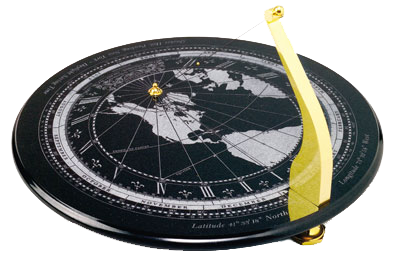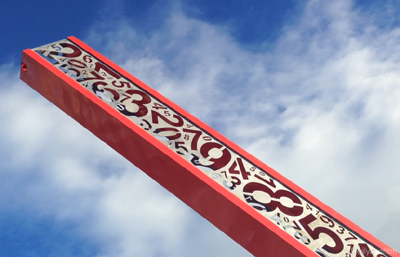- Details
- Hits: 17741
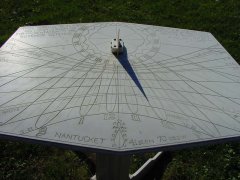 More than 25 years ago Robert diCurcio made a compound sundial. A small round horizontal dial is surrounded by a larger gnomonic dial engraved with hour lines in the shape of analemmas. Careful inspection of the dial shows that the lines are offset from the longitude of 70 degrees to account for the sun at the eastern time meridian of 75 degrees west. In "Yesterday's Island - Today's Nantucket" Katherine Brooks of the Maria Mitchell Association (MMA) takes a close look at the sundial in their front yard, sitting on the lawn of the Maria Mitchell Observatory on Vestal Street.
More than 25 years ago Robert diCurcio made a compound sundial. A small round horizontal dial is surrounded by a larger gnomonic dial engraved with hour lines in the shape of analemmas. Careful inspection of the dial shows that the lines are offset from the longitude of 70 degrees to account for the sun at the eastern time meridian of 75 degrees west. In "Yesterday's Island - Today's Nantucket" Katherine Brooks of the Maria Mitchell Association (MMA) takes a close look at the sundial in their front yard, sitting on the lawn of the Maria Mitchell Observatory on Vestal Street.
Here is a slight correction to the article's text: diCurcio set up the sundial perfectly level and oriented it so that the meridian-line is exactly north-south. [Hopefully aligned to true north, NOT magnetic north.] Once the dial is aligned the triangular gnomon will cast a shadow not only for the small horizontal dial telling east coast solar time, but the tip of the gnomon shadow points to the analemma, the “figure of eights”, which shows standard or daylight mean time (clock time). Installed by diCurcio, the sundial at the Maria Mitchell Association is accurate to this day. Brooks writes,"We hope you stop by the Maria Mitchell Vestal Street Observatory on Vestal Street to see the 1908 observatory built by the MMA and to test out the Sun d’Isle on the lawn in front. If reading shadows interests you, we encourage you to attend our Summer Speaker Series this Tuesday, August 30,[2016] to learn about the “Effects of Light at Night” with Dr. Mario E. Motta."
Compare the photo of the MMA sundial from Brook's article http://yesterdaysisland.com/what-is-this-a-sundial/ with the sundial photo above that appears in the NASS Sundial Registry at http://www.sundials.org/index.php/component/sundials/oneDial/513
- Details
- Hits: 10212
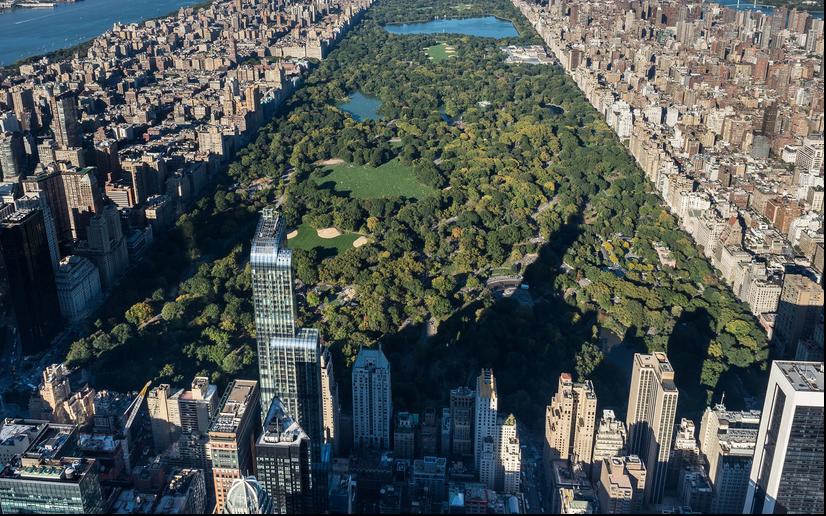 Michael Lee's photograph of Central Park started it all. Erika Owen (TravelandLeisure.com) wrote "If you think Central Park is only good for its slightly quieter reprieve from the hustle and bustle of the Big Apple, you're missing out. As it turns out, the park can actually be used as a giant sundial. Understandably, this isn't a universally accessible perk of the park...you'd need to be in an airplane or helicopter to truly appreciate the functionality."
Michael Lee's photograph of Central Park started it all. Erika Owen (TravelandLeisure.com) wrote "If you think Central Park is only good for its slightly quieter reprieve from the hustle and bustle of the Big Apple, you're missing out. As it turns out, the park can actually be used as a giant sundial. Understandably, this isn't a universally accessible perk of the park...you'd need to be in an airplane or helicopter to truly appreciate the functionality."
Any vertical ediface such as a tall building, a flagpole, or even the Washington Monument can become a gnomonic sundial measuring time by the tip of their shadow. But seeing those shadows on the ground results in fuzzyness of the penumbral shadow. The solution? Step back, way back to a perspective of seeing the shadows from high in the air. From this view these giant sundials become visible. Owen continues, "Billionaire's Row, the name given to the skyscrapers lining the two blocks south of the park between Fifth Avenue and Central Park West gives off plenty of shadows..."
To see the shadows in motion, Cube Cities presents a short video "Central Park Shadows". Cube Cities specializes in urban city representations and animation software to create them. For example they visualize the growth of cities as Manhattan from the 1920s and the growth of San Franciso from 1977 to 2015 and Chicago from 1862 to 2014.
- Details
- Hits: 14047
An analemmatic sundial was dedicated July 4th 2016 at noon in the Frontier Heritage Park at La Pine, Oregon. The Daniel and Crystal Richer Family Foundation created a simple but accurate sundial where one's own shadow tells the time. The sundial honors veterans and the unmentioned heros of our country. The plaque sums it all: "Always Remember".
The video is from KTVZ, Channel 21: http://www.ktvz.com/news/new-la-pine-sundial-to-honor-veterans/40269620
- Details
- Hits: 21196
News Item from the Wet Mountain Tribune on June 30th, 2016: Custer County courthouse is getting a new sundial. Using a true north line surveyed by county commissioner Kit Shy, Charlie French is cementing a rod anchored in obsidian rock, whose shadow will align with that of the courhouse flagpole. "Taking advantage of the summer solstice on June 20, he literally nailed down the farthest reach of the flagpole shadow."
While French happily proclaims, “thanks to Harrison [whose clock allowed longitude determination in 1761], and knowing where the time zone meridian is, and how distant we are from it, we are accurate to one minute and 51 seconds of Mountain Time here in the visible solar time at the courthouse.” Well, that's almost correct. French's gnomon rod and courthouse flagpole shadows align at local solar time. Mountain Time like other clock times do not match solar time due to the tilt of the earth's axis and eccentric orbit around the sun, shifting solar and clock time by +/- 15 minutes throughout the year. Read more at: http://www.wetmountaintribune.com/home.asp?i=945&p=6
- Details
- Hits: 12260
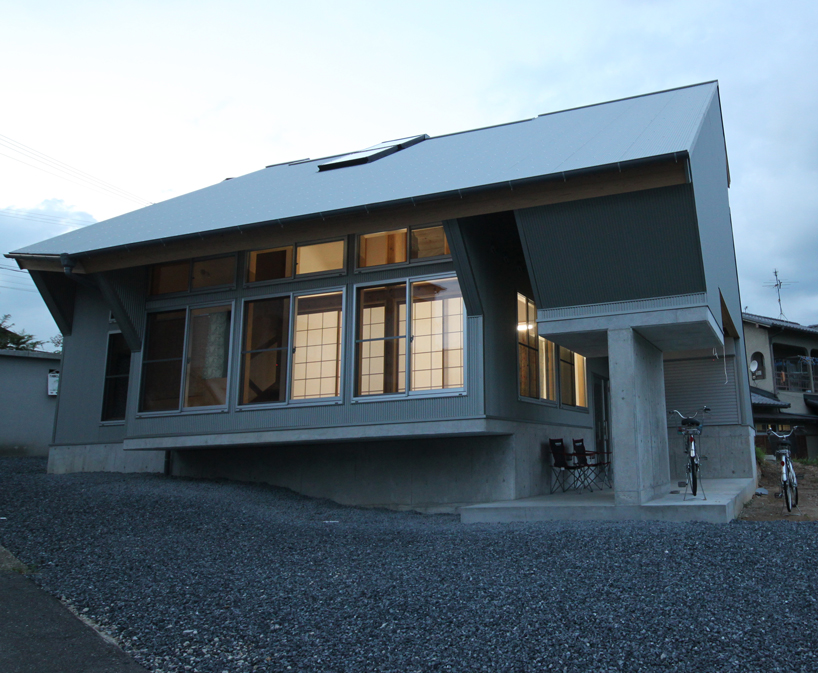 |
As reported in Design Bloom architect Kikuma Watanabe has designed a beautiful modern house integrating asundial and solar design principles: "The internal spaces support a comfortable environment where in summer it is naturally cool and in the winter it is warm. This ecological technology aids this passive system using the sun and the wind for an effective air conditioner."
The interior of the house has two-story rooms and lots of natural wood. But unlike other houses except perhaps for the Cosmic Room in Corregadora, Mexico, it has a built in equatorial sundial. Central stairs lead up to the equatorial dial projection area with the gnomon itself a glass slit window in the roof. But the most important aspects for solar comfort are the angles of the eve overhangs, preventing hot summer sun from entering the windows yet allowing warming sunlight to enter during the winter . Brighter areas such as the kitchen are situated in rooms with southern exposure while the living room faces east looking out upon ponds and hills. Upstairs surrounding the equatorial dial projection ring are two rooms: the Room of Sunrise and the Room of Sunset, and on the main floor facing north is the Room of Shadow.
- Details
- Hits: 12488
|
Example of an Andrewes Longitude Sundial |
Texas Christian University (TCU) in Fort Worth Texas will unveil a new longitude sundial on May 5th, 2015. As William Andrewes, creator of the longitude dial explains, "The Longitude Dial is based on an idea proposed in 1607 by Franz Ritter of Nuremburg...Ritter devised and published a world map projected from Nuremburg, with its lines of longitude arrayed to serve also as hour lines. However, the difficulties of creating a new project for each location and the expense of producing it in durable materials were considerable. Ritter's gnomonic projection map does not appear to have been developed for use in sundials - until now." See Andrewes website at: http://www.longitudedial.com/index.html
One of Andrewes sundials will be unveiled in front of Walsh Performing Arts Center, situated in the middle of a circular stone plaza. Andrewes monumental sundial prices start at $50,000. Read more at TCU-360 news
As an interesting side note, the gnomonic project map upon which Andrewes creates his sundials was extensively used during World War II and into the 1950's by high frequency (HF) direction finding (DF) sites. On the gnomonic map not only are lines of longitude straight, but any great circle line of bearing is straight as well. Using a pin on the DF site, the lines of bearing could be drawn with an extended piece of string. Computer calculations eventually replaced the manual direction finding and geolocation method.
- Details
- Hits: 18061
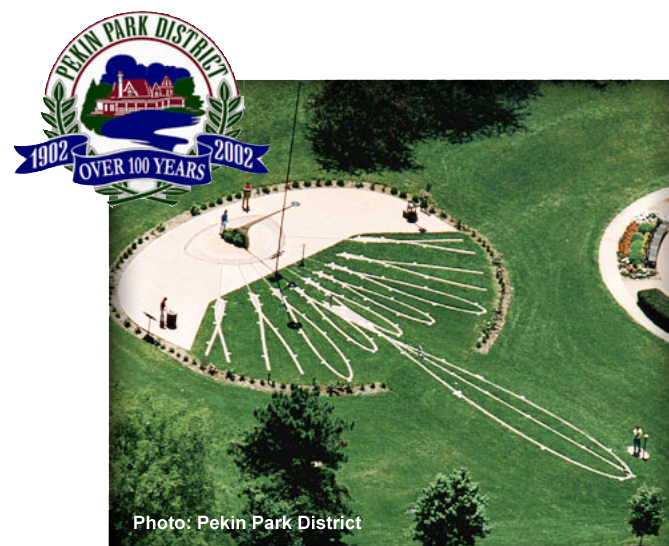
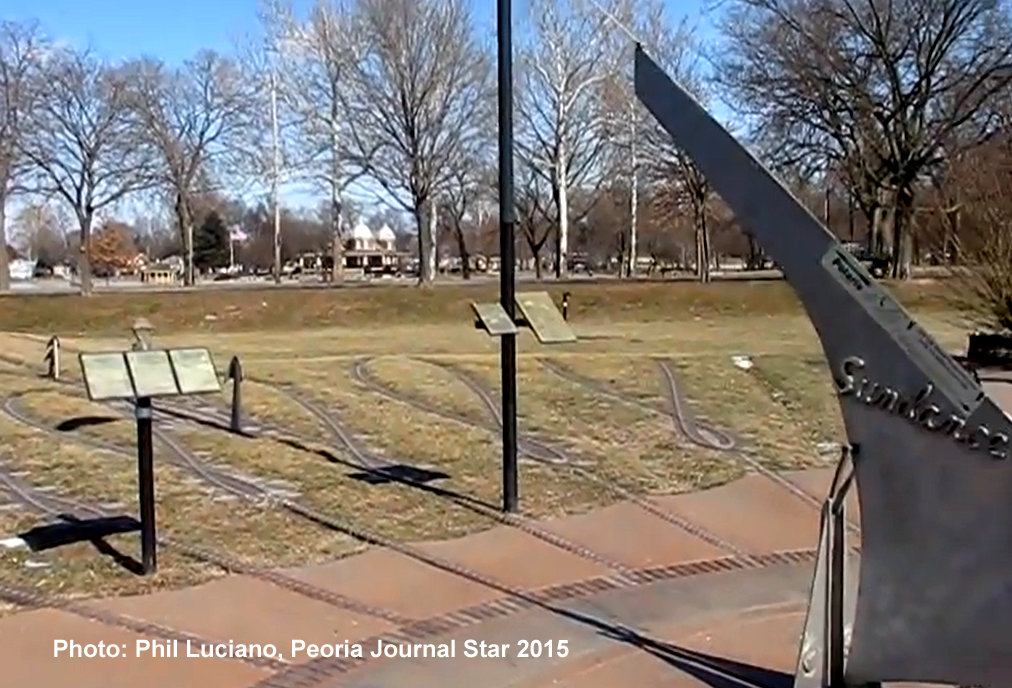
Of the 101 things that play in Peoria, the Pekin Illinois Sundial in Mineral Springs Park is rated #59, and billed as the World's greatest sundial in Pekin, Illinois. Even Google Maps marks the Pekin Sundial. The Pekin Park District says: "picturesquely located in the Sunken Gardens in Mineral Springs Park, this unique sundial tells the hours before or after noon and the highest point of the sun on a given day. More interesting information is available on the earth, sun, planets and latitude and longitude at the site."
The Peroria Journal Star interviewed Hentry Cakora, now 79, who built the dial using his family business, Tazewell Machine Parts and convinced the Pekin Park District to provide land for its construction in the Sunken Gardens of Mineral Springs Park. It's easy to spot on Google Maps just south of Court Street near the park's Lagoon that from spring through fall offers a pedalboat rides.
Cakora who knew about the sun's motion and was good at mathematics created a complex set of sundials. The main sundial is a horizontal dial about 6 feet tall of burnished steel, surrounded by hour marks on the ground. But if you're there near noontime there are extra treats. At the base of the sundial is a thin upright triangle split down the middle allowing it to cast a narrow beam of light toward the noon mark. Then there is a pole just north of the dial with two flat nodi about 12 inches in diameter, each having a hole in the center. The lower nodus casts a shadow that each hour falls on an analemma that allows correction for the sun's irregular "Equation of Time". Charts explain this to the observer as well. The upper nodus casts its shadow on a noon mark analemma, with small stakes to indicate the soltices and equinox.
Nearby is a planet. Is it part of a planet trail that starts from the Park's nearby fountain? Or is there another astronomical explanation? In any event, if the Pekin dial isn't one of the World's greatest, Cakora declares “I’m sure, by far, it’s the most accurate."
Read about it in the Peoria Journal Star: http://101.pjstar.com/59-worlds-greatest-sundial/ and see at: http://www.pekinparkdistrict.org/sundial.html
- Details
- Hits: 16411
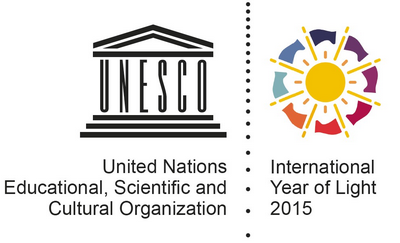 A Letter to NASS regarding the IYL-2015 and the Literary Competition "Words and Light"
A Letter to NASS regarding the IYL-2015 and the Literary Competition "Words and Light"I would like to send you the direct link to more details on this competition, as I believe it may be of interest for some members of the NASS (I saw the Art and Literature section in the "Teachers Corner"). The deadline for submitting entries is coming soon - 31 March:
“Words and Light” is a tribute to all the writers who were inspired by Light, writers who were interested in the Science of Light, and scientists who were also poets. The Competition is dedicated to Mikhail Vasilyevich Lomonosov and Johann Wolfgang von Goethe, celebrating the publication of the grammar book by Lomonosov written in 1755 which reformed the Russian literary language by combining Old Church Slavonic with the vernacular (160th anniversary in 2015), and to the book "Theory of Colours" (Zur Farbenlehre) by Goethe, published in 1810, which contains detailed descriptions of phenomena such as coloured shadows, refraction, and chromatic aberration (205th anniversary in 2015).
Yours sincerely,
Ana Luisa
--
Dr. Ana Luisa Simoes Gamboa
Associate Professor, Department of Industrial Ecology
ITMO University (Saint Petersburg National Research
University of Information Technologies, Mechanics and Optics)
Saint Petersburg, Russia
+7 911 716 37 22
- Details
- Hits: 19678
|
SOLART2 by artist MA2F |
UNESCO has declared 2015 the International Year of Light and Light-Based Technologies (IYL-2015). For sundialists, the inauguration of SOLART2 on the June 2015 solstice may be the highlight. SOLART2 is the largest IYL-2015 artistic sundial project in Europe. It is located in Rivesaltes at the northern entrance of Perpignan, France. It was initiated in 2013 as a strong symbol of sustainable development. Artist MA2F (Marc-Andre 2 Figuères) is constructing the sundial with an incredibly large gnomon created from a double metal bar with numbers silouhettes cut into the structure. The dial is meant to illustrate the flow of matter and energy, projecting a continually changing shadow of numbers onto the dial face during the progression of solar time. The edges of the gnomon are painted red "as a visual value and mastery of light". You can see a video of the dial at: http://ma2f.com/pages/solart2.php

